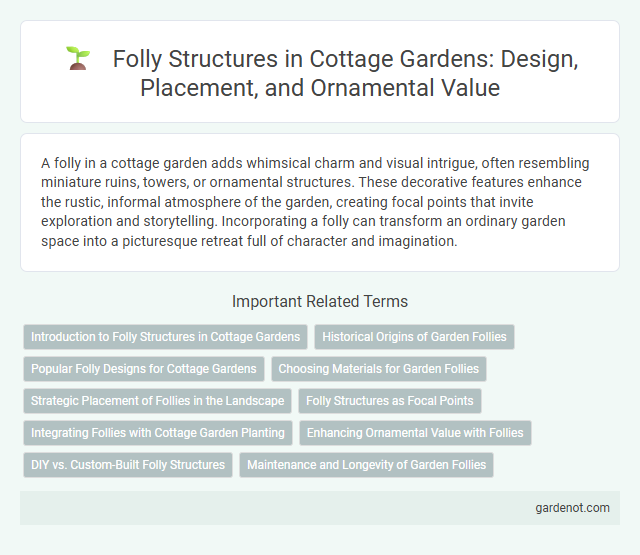A folly in a cottage garden adds whimsical charm and visual intrigue, often resembling miniature ruins, towers, or ornamental structures. These decorative features enhance the rustic, informal atmosphere of the garden, creating focal points that invite exploration and storytelling. Incorporating a folly can transform an ordinary garden space into a picturesque retreat full of character and imagination.
Introduction to Folly Structures in Cottage Gardens
Folly structures in cottage gardens serve as whimsical architectural features that enhance the landscape's charm and visual interest. These ornamental buildings, often resembling miniature castles, towers, or rustic ruins, provide focal points and evoke a sense of history or fantasy within the garden. Incorporating follies can create unique spaces that blend seamlessly with the informal, naturalistic planting style typical of cottage gardens.
Historical Origins of Garden Follies
Garden follies originated in 18th-century Europe, serving as ornamental structures that showcased wealth and artistic taste within cottage gardens and estates. Often designed as faux ruins, classical temples, or whimsical towers, these follies reflected romantic fascination with antiquity and nature. Their historical significance lies in blending architecture with landscape, enhancing the cottage garden's aesthetic and cultural value.
Popular Folly Designs for Cottage Gardens
Popular folly designs for cottage gardens often include charming features such as whimsical gazebos, rustic birdhouses, and miniature stone ruins that enhance the garden's nostalgic and romantic atmosphere. These elements provide focal points that complement the informal planting style typical of cottage gardens, integrating seamlessly with flowering borders and climbing plants like roses and clematis. Incorporating traditional materials like weathered wood, brick, and natural stone helps maintain the authentic cottage garden aesthetic while offering functional garden structures.
Choosing Materials for Garden Follies
Selecting materials for garden follies is crucial to achieving the desired aesthetic and durability in a cottage garden. Natural stone, reclaimed wood, and weather-resistant metals like corten steel provide authenticity and withstand outdoor conditions effectively. Incorporating locally sourced materials enhances sustainability and ensures the folly harmonizes with the surrounding landscape.
Strategic Placement of Follies in the Landscape
Strategic placement of follies in a cottage garden enhances visual interest and creates focal points that guide visitors through the landscape. Positioning these ornamental structures near winding paths, secluded garden rooms, or water features can evoke surprise and delight while complementing the informal, naturalistic style of the garden. Thoughtful siting also balances the garden's composition by introducing vertical elements and varying textures within the lush, romantic planting schemes.
Folly Structures as Focal Points
Folly structures serve as enchanting focal points in cottage gardens, drawing attention with their whimsical and often historical architectural designs. These ornamental buildings enhance the garden's charm by providing visual interest and a sense of mystery or storytelling. Integrating materials like stone, wood, or wrought iron, follies complement the natural, informal planting style typical of cottage gardens.
Integrating Follies with Cottage Garden Planting
Integrating follies into cottage garden planting enhances the whimsical charm and creates focal points that complement informal, dense plantings of flowers like foxgloves, hollyhocks, and delphiniums. These ornamental structures, such as gazebos, arbors, or small towers, blend seamlessly when surrounded by mixed borders and climbing roses, encouraging a natural yet curated aesthetic. Thoughtful placement of follies promotes visual interest and depth, amplifying the romantic, storybook feel typical of traditional cottage gardens.
Enhancing Ornamental Value with Follies
Follies in a cottage garden serve as captivating focal points that enhance the ornamental value by blending whimsical architecture with natural beauty. These decorative structures, often inspired by classical ruins or fantasy motifs, create visual interest and invite exploration, enriching the overall garden experience. Strategically placed follies complement lush flower beds and winding paths, elevating the garden's charm and character.
DIY vs. Custom-Built Folly Structures
DIY folly structures in cottage gardens offer cost-effective, personalized charm, allowing gardeners to creatively repurpose materials and tailor designs to their landscape. Custom-built folly structures provide durability and architectural precision, often crafted by skilled artisans to complement the garden's aesthetic with intricate details. Choosing between DIY and custom-built options depends on budget, desired craftsmanship level, and the intended impact on the garden's visual harmony.
Maintenance and Longevity of Garden Follies
Garden follies require regular maintenance to preserve their aesthetic and structural integrity, including cleaning, repainting, and repairing cracks or damages caused by weather exposure. Using weather-resistant materials like treated wood, stone, or metal can significantly enhance their longevity in a cottage garden setting. Proper drainage and positioning away from excessive moisture help prevent deterioration and prolong the lifespan of garden follies.
Folly Infographic

 gardenot.com
gardenot.com